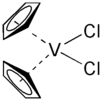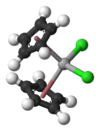Vanadocene dichloride
| |||
| Names | |||
|---|---|---|---|
| IUPAC name
Dichlorobis(η5-cyclopentadienyl) vanadium | |||
| Other names
Dicyclopentadienyl vanadium dichloride | |||
| Identifiers | |||
| 12083-48-6 | |||
| Abbreviations | Cp2VCl2 | ||
| ECHA InfoCard | 100.031.943 | ||
| PubChem | 82917 | ||
| RTECS number | YW1580000 | ||
| Properties | |||
| C10H10Cl2V | |||
| Molar mass | 252.03 g/mol | ||
| Appearance | Green solid | ||
| Density | 1.7 g/ml | ||
| Melting point | decomposes | ||
| Boiling point | decomposes | ||
| Soluble (Hydrolysis) | |||
| Structure | |||
| Monoclinic | |||
| Tetrahedral | |||
| Hazards | |||
| Main hazards | Irritant | ||
| R-phrases | R25 R36/37/38 R38 | ||
| S-phrases | S26 S28 S36/37/39 S45 | ||
| NFPA 704 | |||
| Related compounds | |||
| Related compounds |
Titanocene dichloride Zirconocene dichloride Hafnocene dichloride Niobocene dichloride Tanatalocene dichloride Molybdenocene dichloride Tungstenocene dichloride | ||
| Except where otherwise noted, data are given for materials in their standard state (at 25 °C [77 °F], 100 kPa). | |||
| | |||
| Infobox references | |||
Vanadocene dichloride is an organometallic complex with formula (η5-C5H5)2VCl2 (commonly abbreviated as Cp2VCl2). It is a structural analoque of titanocene dichloride but with vanadium(IV) instead of titanium(IV). This compound has one unpaired electron, hence Cp2VCl2 is paramagnetic. Vanadocene dichloride is a suitable precursor for variety of bis(cyclopentadienyl)vanadium(IV) compounds.
Reduction of vanadocene dichloride gives vanadocene, (C5H5)2V.
Preparation
Cp2VCl2 was first prepared by Wilkinson and Birmingham via the reaction of NaC5H5 and VCl4 in THF, followed by work up by extraction with chloroform and hydrogen chloride and recrystallization from toluene.[1]
Structure
Like titanocene dichloride, this organovanadium compound is currently being investigated as a potential anticancer drug (currently in clinical trials). The mechanism by which it acts is not understood, but some conjecture that it might be due to its interactions with the protein transferrin.[2]
References
- ↑ Wilkinson, G.; Birmingham, J. G. (1954). "Bis-cyclopentadienyl Compounds of Ti, Zr, V, Nb and Ta". J. Am. Chem. Soc. 76 (17): 4281–4284. doi:10.1021/ja01646a008.
- ↑ Murthy, M. S.; Rao, L. N.; Kuo, L. Y.; Toney, J. H.; Marks, T. J. (1988). "Antitumor and toxicologic properties of the organometallic anticancer agent vanadocene dichloride.". Inorg. Chim. Acta. 152 (2): 117–124. doi:10.1016/S0020-1693(00)83343-5.
Further reading
- Hirao, T.; Ogawa, A.; Asahara, M.; Muguruma, Y.; Sakurai, H. (2005). "d,l-Selective Pinacol-Type Coupling Using Zinc, Chlorosilane, and Catalytic Amount of Cp2VCl2; dl-1,2-Dicyclohexylethanediol". Org. Synth. 81: 26.


